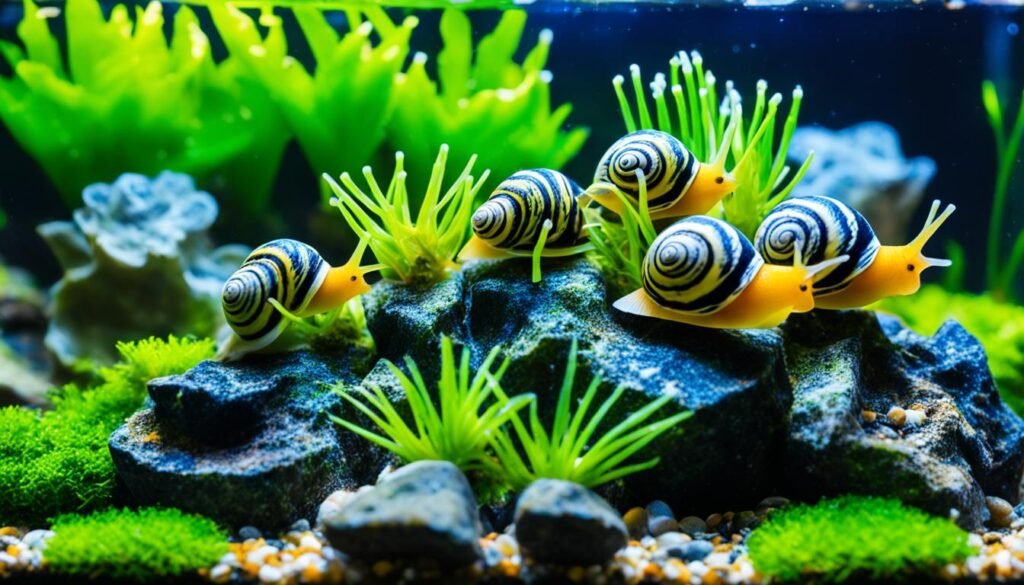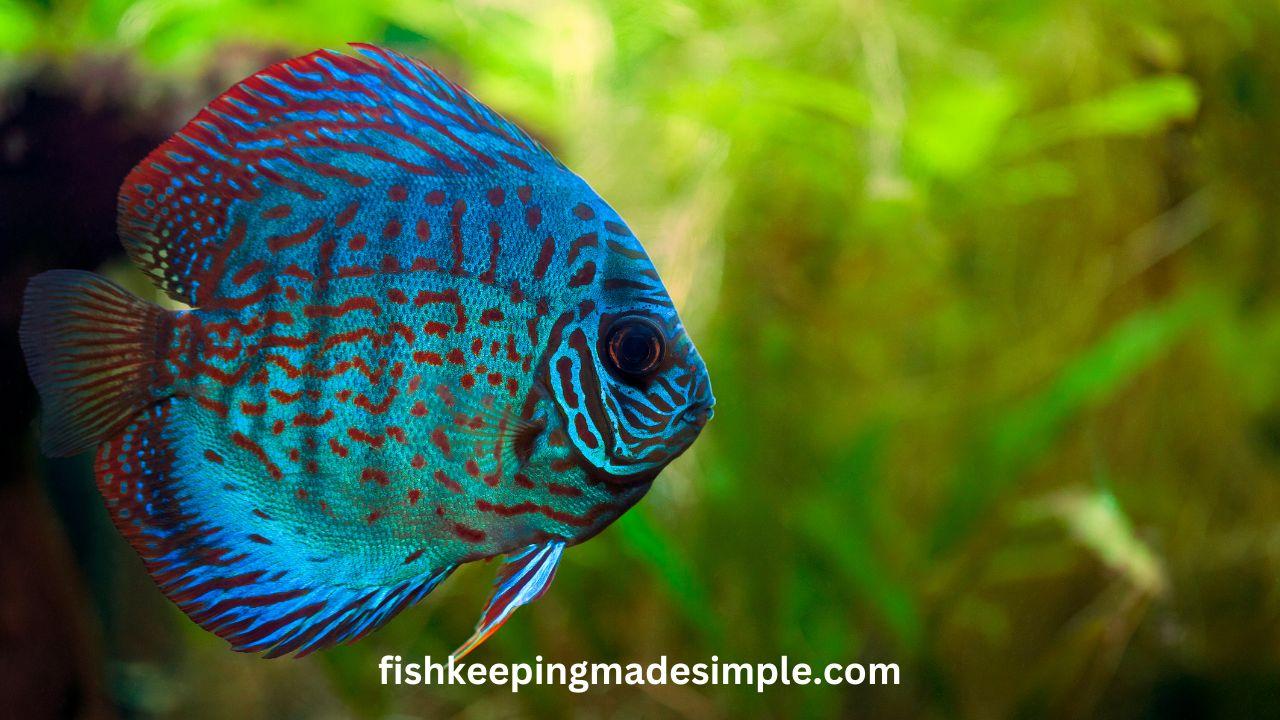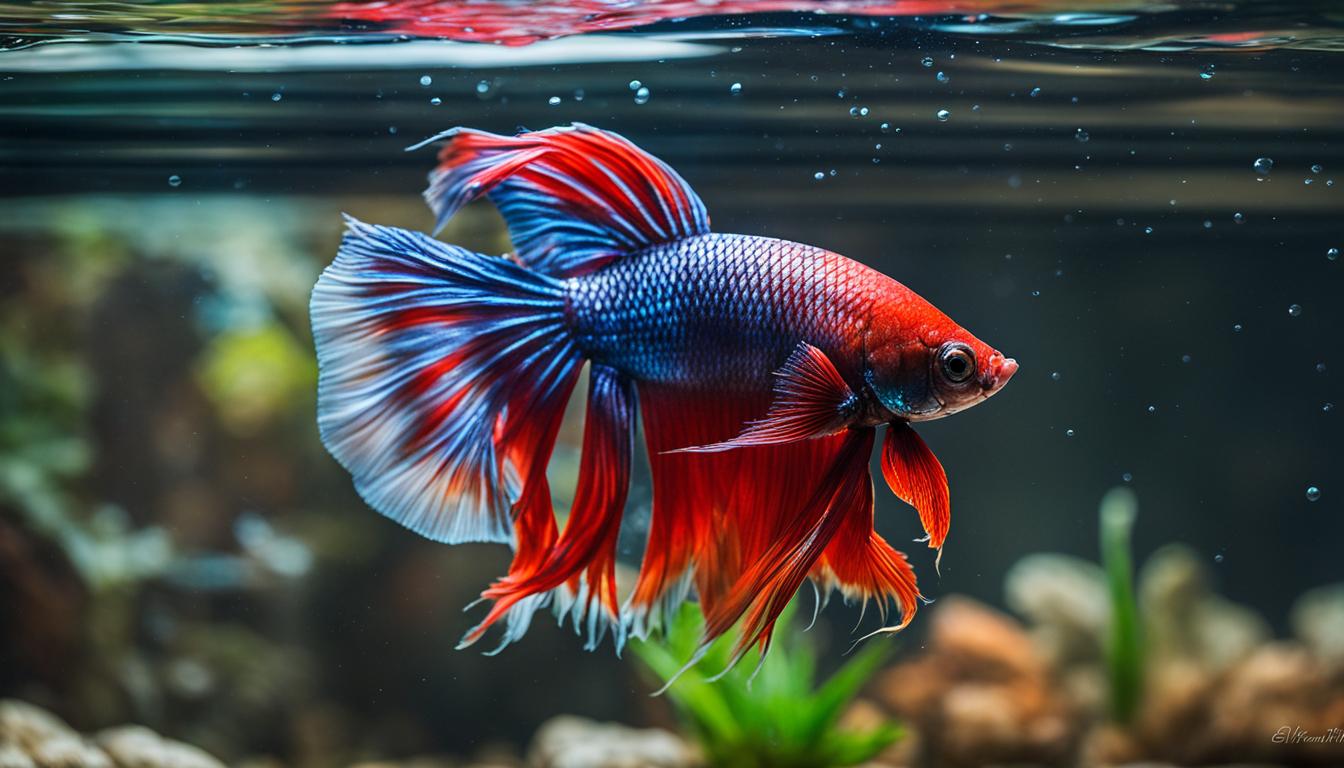Did you know a single nerite snail can clean a significant part of your tank in a day? These tiny freshwater snails are excellent at getting rid of algae. They keep your tank clean and looking beautiful. Whether it’s your first time with live snails or you’re adding to your collection, this guide has everything you need. It will help ensure your nerite snails are healthy and happy.
Table of Contents
Key Takeaways:
- Nerite snails work hard to eat lots of algae, which keeps your tank clean.
- There are different kinds of nerite snails, like Neritina natalensis and Neritina zebra. Each one has its own look and traits.
- For happy nerite snails, set up their tank right. Include proper water conditions, food, and friends.
- Nerite snails can get back on their feet unless they’re bothered by other creatures in the tank.
- Looking after water quality, food, and the tank environment helps nerite snails live longer.
What are Nerite Snails?
Nerite snails are interesting creatures from the Neritidae family. You can find them near the coasts of Africa and the Indo-Pacific. Each species has unique features.
The zebra nerite snail is a well-liked type. Its shell has black and gold stripes, looking like a zebra. There are also the black racer, red racer, tiger, and horned nerite snails. Sizes range from half an inch to an inch and a half.
Nerite snails stand out because of their colorful, patterned shells. You might see solid colors, stripes, dots, zigzags, or even spikes. They make any tank look beautiful.
| Species | Colors | Patterns | Size |
|---|---|---|---|
| Zebra Nerite | Black, gold | Stripes | 0.5-1 inch |
| Black Racer | Black | Solid | 0.6-1.2 inches |
| Red Racer | Red | Solid | 0.5-1 inch |
| Tiger Nerite | Black, orange | Stripes | 0.8-1.5 inches |
| Horned Nerite | Black, yellow | Spikes | 1-1.5 inches |
Can nerite snails flip themselves over?
Yes, nerite snails can flip over if they’re upside down. They have a special skill for this. It helps them in their wild homes, facing uneven ground or predators.
They use their strong foot to flip back up. This foot movement creates a twist, letting them roll over. It’s an amazing ability they have.
But, there are times when flipping is hard for them. For example, if tank mates bother them too much. Then, it becomes tough for them to flip. So, keeping the tank peaceful is crucial for their health.
Now, we’ll look into why nerite snails might die and how we can stop it.
| Nerite Snails | Ability |
|---|---|
| Species | Flipping themselves over |
| Colorful shells | Stripes, dots, zigzags |
| Shell patterns | Spikes |
Why do my nerite snails keep dying?
Several reasons could cause nerite snails to die in your tank. It’s crucial to solve these problems quickly for your snails’ health and happiness. Here are some key points to think about:
- Food: Nerite snails need enough food to stay healthy. If they don’t eat enough, they might get weak and die. Make sure your tank has plenty of algae or give extra food like algae wafers or veggies like zucchini or green beans.
- Minerals: These snails also need minerals to grow their shells and keep healthy. If your tank’s water is missing important minerals, your snails could get sick. You can add minerals to the water with products like Wonder Shells or Seachem Equilibrium.
- Water quality: Bad water is harmful to nerite snails. They can’t handle high levels of ammonia or nitrite, which come from too much waste or not enough filtering. Check your water regularly and change it to keep it clean.
- Signs of a dying snail: Watch for signs your snail might be dying, like if it’s out of its shell a lot or smells bad. If you see these signs, take the sick snail out right away to keep the tank safe and clean.
To help your nerite snails live better, tackle these issues. Watch their food, give them the right minerals, and keep the water clean. This way, you can help them live longer and avoid losing them too soon.
How to Set Up an Aquarium for Nerite Snails
If you want nerite snails in your aquarium, setting up the tank right is key for their health. Follow these steps:
1. Choosing the Right Tank Size
Nerite snails do well in tanks as small as 2-3 gallons. But they need space to move freely. For a group of snails, a bigger tank is better.
2. Maintaining Tropical Temperatures
Nerite snails like it warm, between 74-82°F (23-28°C). A good aquarium heater keeps the temperature steady. This helps your snails stay healthy and lively.
3. Setting up a Freshwater Environment
Nerite snails love freshwater. Aim for a pH above 7.0, on the alkaline side. Use crushed coral or mineral supplements to keep the pH right. These also give your snails needed minerals.
4. Paying Attention to the Waterline
Don’t fill the tank too much. Nerite snails can be out of water for a bit. But, they need to be underwater to do well.
5. Investing in a Tight-Fitting Lid
Nerite snails might try to explore outside their tank. A secure lid prevents them from getting out. It keeps them safe inside.
This image shows the beauty of nerite snails. You can see their vibrant colors and unique patterns.
What fish can live with nerite snails?
Choosing friends for your nerite snails in the tank means you’ll want peaceful pals. Nerite snails are cool with many fish that are chill like them. Here are some buddies that work well with nerite snails:
Small Tetras
Small tetras are a good choice. Think neon tetras, ember tetras, or glowlight tetras. These little fish with their bright colors get along fine with nerite snails in a shared tank.
Rasboras
Rasboras are also great friends for nerite snails. Choices like harlequin rasboras or celestial pearl danios are peaceful. They like the same type of water too.
Corydoras
Corydoras catfish are a top pick for friends that live at the tank’s bottom. These friendly fish match well with nerite snails. They also clean up leftover food, which keeps the tank tidy.
Similar-Sized Invertebrates
Looking for a tank full of different tiny creatures? Add some shrimp or Malaysian trumpet snails. These invertebrates are no trouble for nerite snails. They all live calmly together.
But, some fish are a no-go with nerite snails:
- Pufferfish: Pufferfish can be bullies. They might hurt or eat nerite snails.
- Snail-Eating Loaches: Some loaches, like clown loaches or yo-yo loaches, eat snails. So, they are bad news for nerite snails.
- Fish that Nibble: Avoid fish that like to pick at snail parts, like tiger barbs or some cichlids. They’re not good tank mates for nerite snails.
Choose the right friends for your nerite snails to make everyone happy. You’ll have a tank where everyone gets along.
| Tank Mate | Suitability |
|---|---|
| Small Tetras | Compatible |
| Rasboras | Compatible |
| Corydoras | Compatible |
| Similar-Sized Invertebrates | Compatible |
| Pufferfish | Not recommended |
| Snail-Eating Loaches | Not recommended |
| Fish that Nibble | Not recommended |
What do Nerite Snails Eat?

Nerite snails are great cleaners in the aquarium. They love to eat algae, helping to control its growth. They make sure your fish live in a neat and healthy place. Let’s see what they like to eat:
- Algae: Nerite snails mostly eat algae in their natural setting. They munch on green spot algae, diatoms, and filamentous algae. They have a special mouthpart named a radula. This helps them scrape and eat algae off various surfaces in the tank.
- Leftover Fish Food: These snails also eat leftover fish food. They snack on food that sinks to the bottom or lies on the substrate. This stops the excess food from rotting and spoiling the water.
- Decaying Leaves: If your tank has live plants, you might see nerite snails eating decaying leaves. They help decompose organic matter. This reduces the chances of rotting stuff making the water dirty.
Nerite snails are great at eating algae but won’t harm healthy plants. So, adding them to your tank won’t damage your plants.
If your tank doesn’t have enough algae for the snails, you can give them special snail food. Algae wafers, blanched zucchini, and canned green beans are good choices. These foods are similar to the algae they eat in the wild and give them important nutrients.
Targeted Algae Control
Nerite snails are also great at getting rid of tough green spot algae. This algae usually grows on plant leaves and hard surfaces. It’s hard to clean off. But nerite snails can handle this problem. They help keep your tank looking good.
To wrap up, nerite snails are helpful cleaners. They eat algae, leftover food, and decaying leaves. Their diet helps keep your aquarium balanced. This makes sure your fish and plants live in a clean and healthy place.
How to Breed Nerite Snails
Breeding nerite snails is a tricky task that needs careful attention. Their young are tough to feed and need saltwater to hatch well. We will cover the key steps and tricks for breeding nerite snails successfully here.
Requirements for Breeding
To breed nerite snails, understanding their needs is crucial. They need a male and a female to reproduce, as they cannot do it alone. For a good chance of success, start with a group of at least six snails. This helps get the right mix of males and females.
Breeding Methods
There are several ways to breed nerite snails. One way is to slowly make the tank’s water saltier, moving the snails to brackish water. Another method lets snails lay their eggs in fresh or brackish water. Then, the eggs are moved to another tank with the right salt level.
Egg Capsules
Nerite snails lay special egg capsules when they reproduce. These hard, white capsules look like tiny sesame seeds. They hold many eggs inside. The capsules stick to the aquarium’s glass, rocks, or decorations. This keeps the baby snails safe as they grow.
Nerite Snail Lifespan, Appearance, and Tank Requirements

When talking about nerite snails, you should know a few key things. These include their lifespan, how they look, and what they need from their tank.
Lifespan of Nerite Snails
Nerite snails usually live between 1 to 2 years. Although this might not seem long, these snails can be a delightful part of your tank.
Appearance of Nerite Snails
Nerite snails vary in size from 0.5 to 2.5 inches. Their big shells protect their bodies. They have many colors and patterns, like stripes, dots, and more. This makes them a beautiful addition to any aquarium.
Tank Requirements for Nerite Snails
It’s important to create the right environment for nerite snails. They need specific conditions to stay healthy and live well.
- Water Temperature: They do best in water that’s 64-84 degrees. Keeping the temperature stable is key.
- Water Parameters: These snails need water with a pH of 6.5-8.5. Check and adjust the pH regularly to keep it right.
- Tank Size: Give each nerite snail at least 5 gallons of water. This gives them enough room to move freely.
- Lighting: Keep the light dim or moderate to protect the snails. Use a dimmer or place the tank away from direct light.
- Substrate: Choose a substrate that’s soft. Hard or rough materials can harm their delicate bodies and shells. Soft gravel or sand is best.
Meeting these water, tank size, light, and substrate needs creates a perfect home. Your nerite snails will thrive and show off their unique beauty.
| Aspect | Requirements |
|---|---|
| Water Temperature | 64-84 degrees Fahrenheit |
| Water pH | 6.5-8.5 |
| Tank Size | Minimum 5 gallons per snail |
| Lighting | Low to moderate brightness |
| Substrate | Smooth gravel or sand |
Understanding these facts about nerite snails ensures they get the best care. This way, they stay happy and healthy in your aquarium.
Conclusion
Nerite snails are perfect for those who love aquariums and want clean tanks. They are super good at eating algae. This makes them an awesome clean-up team for any aquarium. Plus, they are calm and get along with many other fish and animals in the tank.
To make sure nerite snails do well, you need to give them the right home. This means the water has to have the right pH and minerals. Breeding them can be hard, but it’s not impossible with the correct setup.
Nerite snails are great for so many reasons. They keep your tank clean and looking nice. They also help keep everything in balance. With their cool colors and patterns, they are a pretty sight. Nerite snails are a smart choice for both new and experienced aquarium lovers.
FAQ
What are Nerite Snails?
Can nerite snails flip themselves over?
Why do my nerite snails keep dying?
How to Set Up an Aquarium for Nerite Snails?
What fish can live with nerite snails?
What do Nerite Snails Eat?
How to Breed Nerite Snails?
What is the Nerite Snail Lifespan, Appearance, and Tank Requirements?
References
- International Federation of Online Clubs and Aquatic Societies (IFOCAS)
- Federation of British Aquatic Societies (FBAS)
- Northeast Council of Aquarium Societies (NEC)
- Federation of American Aquarium Societies (FAAS)
- Ornamental Aquatic Trade Association (OATA)
I am a passionate aquarist with over 30 years of hands-on experience in fishkeeping. My journey began at a young age, collecting fish from the wild and learning through experimentation. Specializing in tropical fish, I bring a deep understanding of the hobby to FishKeepingMadeSimple. The site provides honest, detailed reviews of essential products and accessories to help fellow enthusiasts create the best environments for their fish.










[…] maintenance tasks such as monitoring, testing, filtration, and treatment are crucial for keeping your aquarium water clean and […]
[…] Keep your tank and equipment clean by investing in proper cleaners like algae scrubbers, siphon hoses, and magnetic cleaners. […]
[…] regular tank maintenance: Regularly clean the aquarium, including removing uneaten food and debris. This helps maintain optimal water quality […]
[…] can help reduce stress on the shrimp. Additionally, maintaining proper tank conditions is crucial. Cleaning the tank and ensuring stable water parameters before attempting to catch the shrimp will create a safer […]
[…] peaceful freshwater bottom-dwellers like bristlenose plecos and algae-eaters like mystery snails can complement your tank. It is important to choose tank mates that are peaceful and of a similar size to prevent bullying. […]
[…] Snails are great for shrimp tanks because they clean up leftovers. Nerite, mystery, bladder, and Malaysian trumpet snails are good choices. They eat algae and keep the tank healthy. […]